If you ever wondered what an Orthodox Church looks like on the inside, what happens during the Sunday morning service, and what kind of people you might meet there this video is highly recommended. Ted Liedle produced this short 14 minute video of an Orthodox church in Macon, Georgia. Click here or screen shot below for video.
Protestants visiting an Orthodox church for the first may feel lost and confused. One notable difference is the icon screen (iconostasis) setting off the altar area from the main sanctuary area where the congregation is. Another difference is the priest going in and out of the altar area. The priest comes out to: (1) cense the congregation and the icons of the saints in heaven, (2) carry out the Scripture in procession, (3) read the Gospel, (4) carry out the bread and the wine that will be used for the Eucharist, and (5) serve Communion. One may wonder what the significance is of the priest’s going in and out altar area. It is symbolic of God’s saving grace in history. For example in the Small Entrance when the priest carries the Scripture, this symbolizes God revealing himself to humanity in Scripture. Whenever I see the priest walking out and holding up the Scripture I am reminded of Isaiah:
As the rain and the snow come down from heaven, and do not return to it without watering the earth and making it bud and flourish, so that it yields seed for the sower and bread for the eater, so is my word that goes out from my mouth: It will not return to me empty, but will accomplish what I desire and achieve the purpose for which I sent it. (Isaiah 55:10-11)
When I see the priest swinging the censer I am reminded of God instructing Aaron to offer incense at the Old Testament Tabernacle (Exodus 30:7-8) and the worship in heaven (Revelation 5:8). When I see the priest come out carrying the bread and the wine in the Great Entrance I am reminded of that God the Son came to us in flesh and blood for the salvation of the world. When I see the priest coming out of the altar area to serve Communion I am reminded of how God took the initiative reaching out to us and how we need to respond God’s grace by going up to receive his gifts to us.
- View of icon screen separating the altar area from the main sanctuary.
Come and See!
St. Innocent Orthodox Church in Macon, Georgia USA.
Source: http://vimeo.com/62956502

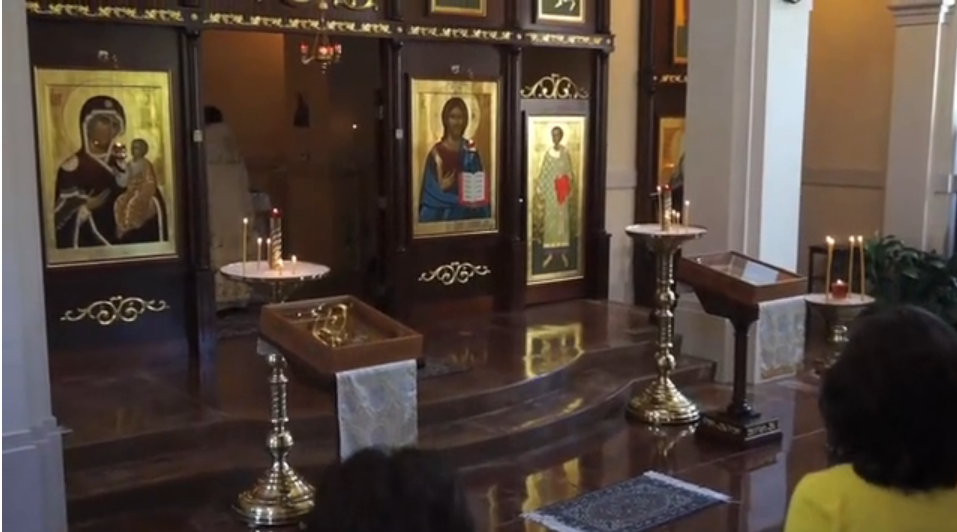

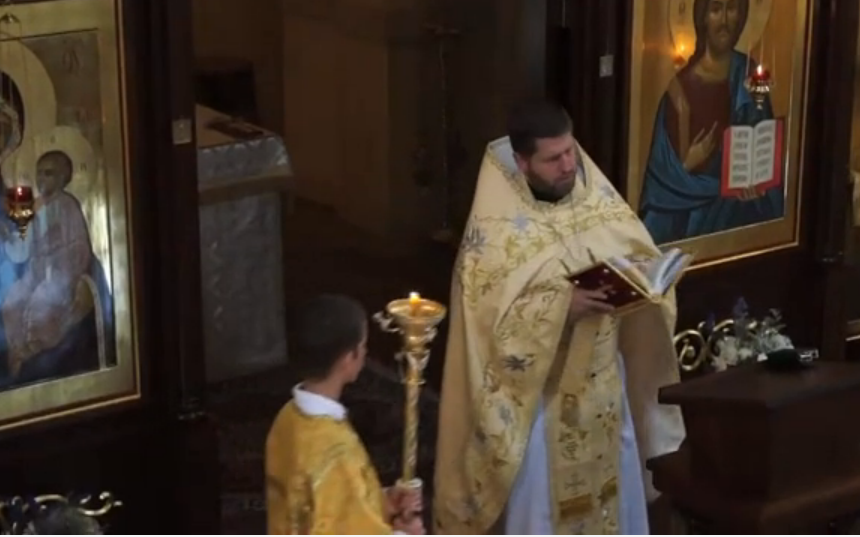
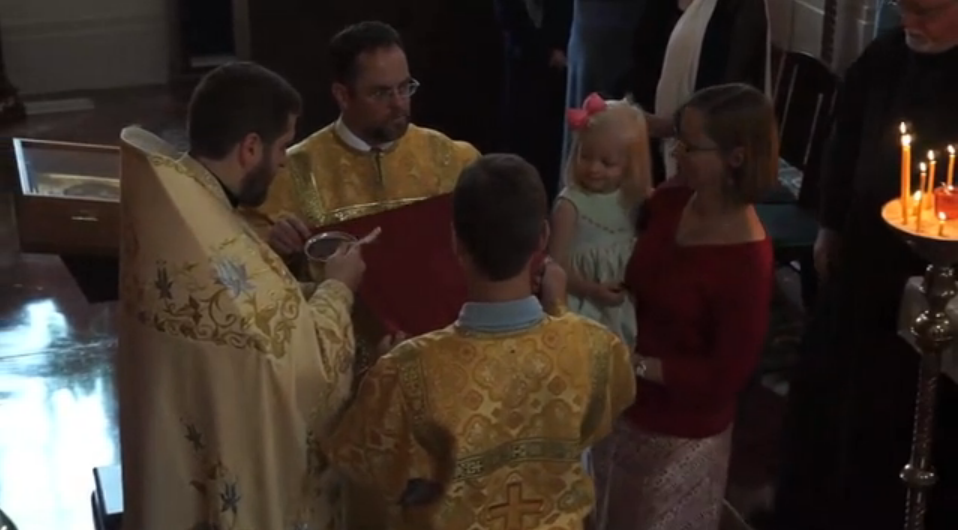
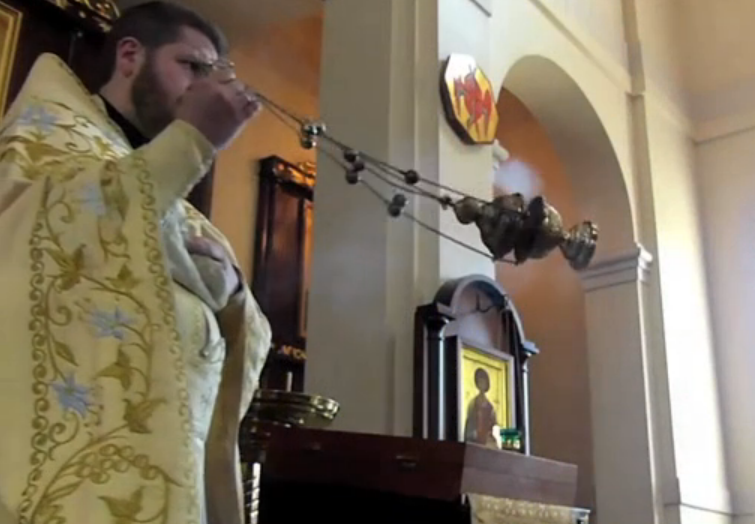
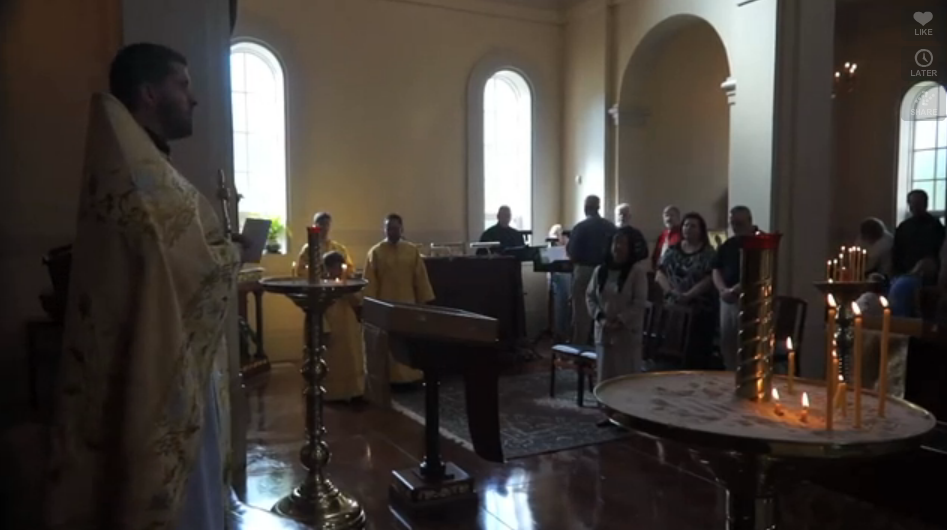
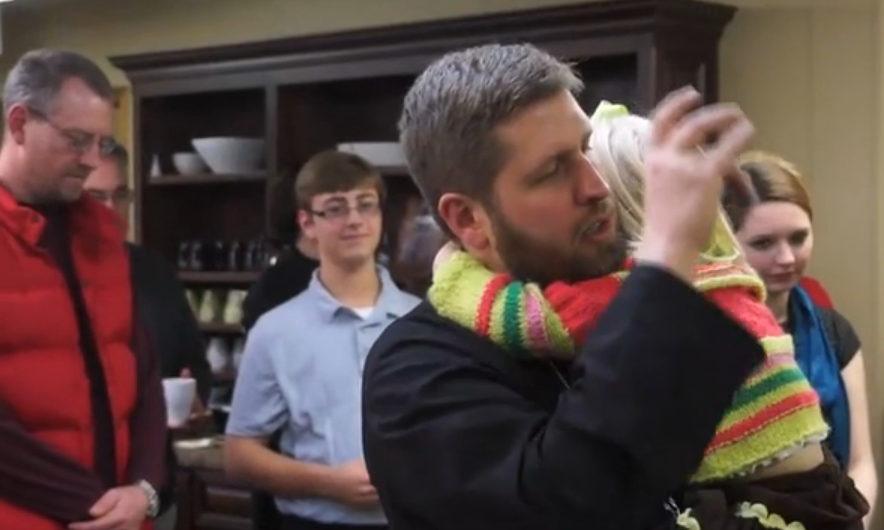
Excellent video. I especially appreciated it because tomorrow will be my first attendance at a Sunday Divine Liturgy. I’ve already been attending the Pre-sanctified Liturgy and the study group.
Mirrie,
I’m glad you liked the video. I pray that you will be richly blessed at tomorrow’s Divine Liturgy.
Robert
The icons used here are evidence of the infiltration of paganism into Eastern Orthodoxy and their break with the traditions of the early church. Early Christians were accused of being “atheists” by Romans who assumed the absence of images meant the absence of belief in gods.
Origen (184-254) responded to the charge of “atheism” by admitting that Christians did not use images in worship, following the Second Commandment.
Canon 36 of the Council of Elvira (c. 305) states, “Pictures are not to be placed in churches, so that they do not become objects of worship and adoration.” About the year 327 the early church historian Eusebius (c. AD 263 – 339) wrote, “To depict purely the human form of Christ before its transformation, on the other hand, is to break the commandment of God and to fall into pagan error.” Epiphanius (inter 310–320 – 403), bishop of Salamis, in Cyprus wrote, in Letter 51 (c. 394), to John, Bishop of Jerusalem about an incident of finding an image in a church in his jurisdiction: “I went in to pray, and found there a curtain hanging on the doors of the said church, dyed and embroidered. It bore an image either of Christ or of one of the saints; I do not rightly remember whose the image was. Seeing this, and being loath that an image of a man should be hung up in Christ’s church contrary to the teaching of the Scriptures, I tore it asunder and advised the custodians of the place to use it as a winding sheet for some poor person.” He goes on to tell John that such images are “contrary to our religion” and to instruct the presbyter of the church that such images are “an occasion of offense.”
For more information see the recently published article: John B. Carpenter, “Icons and the Eastern Orthodox Claim to Continuity with the Early Church,” ”Journal of the International Society of Christian Apologetics”, Vol. 6, No. 1, 2013, pp. 107-122.
John,
Welcome to the OrthodoxBridge! I appreciate your forthright expression of your faith convictions even if I disagree. When I was a Protestant Evangelical I too thought that icons were contrary to Scripture, but my views changed as I delved into Scripture and as read up on church history. When I read the Old Testament carefully I found that God instructed Moses to weave the image of the cherubim (Exodus 26:31) on the curtain before the Holy of Holies. The Old Testament makes further references to the use of images or pictorial depictions in Solomon’s Temple (see II Chronicles 3) and the eschatological Temple (see Ezekiel 41). I urge you to read my earlier article: The Biblical Basis for Icons. You mentioned the Council of Elvira but it needs to be kept in mind that this was a local council and that the more important council was the Seventh Ecumenical Council, Nicea II. There was disagreement in the early Church about whether or not icons should be used in the church; the issue was settled decisively at this ecumenical council making icons part of historic Christian worship. I find much to admire in the preaching of Protestant pastors, but the typical pattern of Protestant worship marks a break from the historic Christian worship. If you believe I am wrong, you would need to show that your Sunday services is similar to that of the early church. Regarding a more detailed discussion of the Council of Elvira and Epiphanius, you can read my response to Burckhardtfan.
Robert
Hi Robert,
Thanks for the reply. I’m sorry that you’ve abandoned the faith and fallen into idolatry.
First, the decorations in the tabernacle (and later temple) were never used in worship; they weren’t bowed before or used in prayer, etc. So they are not icons. The 2nd commandment (Ex. 20:4ff) specifically describes what NOT to do (make an image of anything and bow before it, etc) and that is exactly what the “Orthdoox” do and therefore they are breaking the second commandment.
Second, the historical evidence from the early church is clear: they did NOT use images in worship; they even discouraged decorations lest they be used like icons. Since the “Orthodox” claim that their worship is inherited in unbroken continuity from the early church and since the historical evidence is over-whelming that the early church strictly opposed icons, therefore we conclude that the “Orthodox” claim is groundless. The historical fact is that the “Orthodox” radically broke with the early church and carried on pagan traditions, not Christian ones.
Third, it doesn’t matter that the Council of Elvira was local or what the (second) Seventh Ecumenical Council said (in 787, over four and half centuries after Elvira!). We are not called to follow the traditions of men but the Word of God (Matthew 15:6). When the traditions of men actually conflict with the Word of God, as they do in “Orthodoxy”, then it is actually wrong to follow those traditions.
I’d suggest you read the referenced article and also, seriously, the Word of God and be prepared to abandon your idols.
John Carpenter,
I suggest reading Early Christian Attitudes Towards Images by Steven Bigham.
Give that book a read and I think many of your objections will be answered succinctly and in a scholarly manner, considering the archaeological and textual evidence that we have found.
John
Sadly, most of what you have listed above are mere assertions.
That it is “clear” is only your opinion on the matter because you’ve cited no sources nor provided any actual arguments. Give that book a read and then I think we can have a fantastic conversation about the use of images in worship in the early Church.
John
John,
NPNF2-14. The Seven Ecumenical Councils
Excursus on the Reception of the Seventh Council.
“The reception of the Seventh Council in the East was practically universal. No historian pretends that the iconoclastic opinions had any hold over the masses of the people. It was strictly speaking a court movement, backed by the army, and whenever the images were laid low and their veneration condemned it was by the power of the State, enforcing its will upon a yielding and (as we would call them to-day) Erastian clergy. (Cf. Harnack, History of Dogma, Eng. tr. Vol. iv., p. 326.)”
John,
I hope your church has no images of a cross, image projectors/video, drawings, photos, childrens picture books or anything else inconsistent with iconoclastic worship.
As for bowing and temple “decorations”, the temple is the house of prayer and worship, images were commanded to be there for a reason. They worshipped before images, they did not worship images! The images “icon-ed” what was real and true. The Jews were commanded to pray toward the temple because God chose the temple to “icon” himself:
Heb 9:24 “For Christ is not entered into the holy places made with hands, which are the figures of the true; but into heaven itself, now to appear in the presence of God for us.”
So the temple images are “figures of the true”! Which is likely also why Heb 9:5 says “And over it the cherubims of glory shadowing the mercyseat”. Not just the image of the cherubim, but “the cherubims of glory” themselves shadowing the mercy seat and the handmade images of them were “figures of the true”.
John Carpenter,
Perry Robinson shows why you can’t really use Elvira in the way that you did:
Elvira, Mistress of the Cheesy
quote:
“”One of these is in reference to the council of Elvira in the late third century/early fourth century. (Its exact date can’t be fixed.) Elvira was a local synod in Spain which put forward 81 canons. Canon 36 is usually trotted out in reference to icons. Rarely is the text of the canon given and almost never analyzed. Sometimes the claim is that Elvira forbade all images. Sometimes the claim is that there was no uninamity regarding the legitimacy images in the early church or similar claims. I don’t think the canon supports either claim……””
To read the rest you will have to go there to see it.
Canon 36 of the Council of Elvira (c. 305) is not ambiguous:
“Pictures are not to be placed in churches, so that they do not become objects of worship and adoration.”
First, I would like to point out that you’re using a rather inaccurate translation. See “Is There Really a Patristic Critique of Icons“. Quote:
As you can see, it’s not longer quite so “unambiguous”, especially when on considers that this cannon is only forbidding the painting images on church walls and it came out during the Diocletian persecutions where images painted on church walls might be prone to vandalism by pagans (since they cannot be removed from the church and protected when the church is vacant).
Second, do you accept the other cannons from Elvira? I again quote the above article:
Robert, you have blessed me with this wonderful video. Your work always blesses and enriches me. I pray that someone will be a blessing to you today just as you have been a blessing to me.
Note that the style of imagery in “Orthodoxy” is copied from Greek paganism:
As icons began to creep into the church, sometime after the fourth century, the true Christians believed that the images were idols and that they were associated with the idolatry Christianity had displaced. They believed that the representations of Christ, Mary, and the Apostles, clearly borrowed from pagan idols.
As church historian Henry Chadwick says,
“In this instinct there was a measure of truth. The representations of Christ as the Almighty Lord on his judgment throne owed something to pictures of Zeus. Portraits of the Mother of God were not wholly independent of a pagan past of venerated mother-goddesses. In the popular mind the saints had come to fill a role that had been played by heroes and deities. ” (Henry Chadwick, The Early Church, (The Penguin History of the Church, 1993), 283.)
John,
You are expressing common, very basic, objections to Orthodox worship that anyone who has either converted to or is genuinely interested in Orthodoxy has dealt with. For purposes of commenting on a blog post, it would be better if you would do some basic internet research to find out what the Orthodox response is to your objections, and then respond to that rather than re-hashing old arguments that will not persuade anyone on the board.
Clay,
Thank you for joining the conversation. That’s what this blog site is about.
John, Have you been to an Orthodox service and seen with your eyes what Orthodox worship is like? Have you sat down and talked with an Orthodox priest? It makes a big difference when experience something in the flesh as opposed to just reading about it.
It would be good if you could post your article on your church’s website or give us the URL to your article. I’m curious as to what you have to say.
Robert
The style of icons is NOT a copy of Greek paganism. It is actually the opposite – a reaction AGAINST Greek paganism, as any student of art history will tell you. Greek pagan art used statues and perspective in their paintings. Icons are deliberately 2D because they are not idols or objects to be worshiped.
I worship the Holy Trinity of God, nothing else. I cross myself and kiss icons not because they are idols that can work magic for me, but because I wish to honour the holy men and women depicted in them, because it has pleased God to honour them, and because they are good examples to follow in my walk with God. My faith is physical and experiential, not just intellectual and spiritual, and that is how it is expressed. Christ is at the center of my faith, and that of every Orthodox Christian. All the icons are there to point to Him, not through their own merit or as a panel of gods and goddesses. Every icon of Mary literally has her pointing to Jesus. And it is Jesus I seek to emulate. It may not be your thing, but the icons help me do that. Venerating them is one way of allowing the Holy Spirit to work in my life.
Henry Chadwick, one of the most renown historians of the early church, says that the style of icons is copied from Greek paganism. If you have any actual evidence otherwise, feel free to share it. Merely stating your opinion however is only evidence of your opinion.
Besides, such images are explicitly forbidden by God Himself in the 2nd commandment (Ex. 20:4ff).
I hope you don’t have pictures of your loved ones in the house. And i hope you’ve never kissed a picture of a loved one.
The second commandment?
I get the feeling you already know the response to appealing to the second commandment.
Why did you say it? Who is your teacher? Sure you have the Church’s scriptures in your possession but you were taught by man what to think of it all. Who is this man? What man taught him that?
What’s your understanding of the Church? Where do you come from? Why Protestantism? Why do you deny Orthodoxy when the creation of your faith rests on the bosom of Roman Catholicism? Why do you think you’re right when better scholars than the ones you appeal to deny your opinion. and better scholars than them agree with your opinion. and better scholars than them deny your opinion and so on into infinity.
Why do you attack? Why so proud in your denouncements? Are you a friend ? Who do you pray for?
John,
Do you believe God broke the second commandment when he commanded Moses to make an image of two Cherubim on the cover of the ark of the covenant? And do you believe the Israelites were violating the second commandment when they bowed down in front of the ark of the covenant, with it cherubic images?
Thanks you for sharing this. The temple is beautiful and it’s clear that the love of Christ is shared within the parish. I will share this with my family and friends.
When I made my first visit to an Orthodox Christian service, I had no idea what to expect. I had read much beforehand, but the written descriptions could not accurately describe the power of the scripture, the music, the prayers, and the focus of the Liturgy on Christ Himself. Having been raised in a committed and faithful evangelical Christian family, and continuing in the tradition for over 50 years, the change was a difficult one which required much prayer and study. However, I now see my previous Christian experience as a shadow of the fullness of the Orthodox Christian Church.
In XC,
Rdr Cornelius
Dear Reader Cornelius,
Yes, let’s pray that this video will inspire others to visit an Orthodox Church and experience the beauty and power of the Divine Liturgy.
Robert
Hey John,
I completely understand where you are coming from. Been there for decades in Reformed Presbyterianism. But there is FAR more to this than you know and you really should read Robert’s article reference above, along with this one http://orthodoxinfo.com/inquirers/thema_response.aspx. Other links here to read and grasp — as the Orthodox men respond to a Protestant critique. Great stuff.
Robert’s other excellent article in the archives interacting with Calvin’s writings is a must read…shocked me as a Protestant and decades-long Calvin lover: https://blogs.ancientfaith.com/orthodoxbridge/calvin-versus-the-icon/
You will learn the early Fathers who believed in Icon actually knew of and dealt with the details of 2nd commandment!
Reading only Reformed and/or Protestant critiques of Orthodoxy…and refusing to allow the Orthodox to speak for himself is simply not intellectually or ethically credible. We’d want the Orthodox to read Calvin and respond to him…right? So brother…let’s have alittle tit-for-tat egh?
enjoy your much reading…
in His tender mercies,
david
Actually, I’ve read early church rejections of icons, which are quite explicit. If you’d like to know the truth about how the early church strictly opposed icons, I suggest you get a copy of:
John B. Carpenter, “Icons and the Eastern Orthodox Claim to Continuity with the Early Church,” ”Journal of the International Society of Christian Apologetics”, Vol. 6, No. 1, 2013, pp. 107-122.
You’ll have to purchase the journal as it is not available on-line.
now available on-line: http://www.isca-apologetics.org/sites/default/files/JISCA-2013-vol-6-no-1.pdf
THANKS for posting this. Some interesting comments on icons and such. It seems apparent to this Christian that the things that are supremely important are that the worshipper be brought closer to the creator God, that they learn and grow in faith and that we reflect our faith in every aspect of our daily lives. This is challenge enough. I am always a little dismayed when the comments on such a nicely done web offering veer toward harsh judgment..so unnecessarily. I am a (struggling) Christian worshipping in a conservative, Orthodox Church setting. Christ’s church has many problems and challenges but we multiply them when we focus judgementally on what, in the end or in the big picture, may be most unimportant. Lots of great references to books and web sites here in the comments. I will add to it only one small and, I think, quite enjoyable reading: “The Eternal Goodness” by John Greenleaf Whittier… here is a link to it. http://www.bartleby.com/42/792.html
God bless you for posting this and to all you who commented.
Dear John H.,
Welcome to the OrthodoxBridge! Thank you for sharing your insights and concerns. I think one reason for the harsh tone by some may be from finding one’s beliefs being unsettled by a new way of looking at the issue. Transitioning from Protestantism to Orthodoxy is not easy. Therefore, we need to keep each other in prayer.
Robert
I love that the priest was very honest and loving in his explanation of Orthodoxy. He was not bashful in his critique of Protestant churches, but presented the critique with respect.
Hello,
I very much enjoyed watching this video, I think it gives me an interesting albeit small insight into the procedure and liturgy of the Orthodox Church. I enjoyed hearing the testimonials from those who made the conversion and it might empower me to do so as well. As a Catholic who is questioning my church, rather then my faith, I think the Orthodox branch of Christianity offers me a lot and it might help me draw closer to God . I like the idea that that the Patriarchs are equal, much like the disciples…rather then a monarchial like the Roman Catholic Church.
To me, even if Jesus had intended for there to be a Pope…the order has become so corrupted by antipopes, lust, and greed that the position is no longer what Jesus intended. The idea of a Church that places values in ancient theology, and traditions is a pretty noble idea to me. I also like how spiritual the Eastern Orthodox church looks to me, at my Roman Catholic Church the masses are unengaged and lifeless, people just go through the motions and move on with their day. I seek a closer bond with God, and what I consider to be “original” catholic traditions that Orthodoxy may be able to offer.
I am thinking about visiting a local Orthodox service, but I am still nervous. Is it advisable to contact the priest ahead of time, or just go? Would it be better to go to a Western Rite Church? I seek answers…so if anybody knows of any books, videos etc. please post the info.
-Marcus
Marcus,
Welcome to the OrthodoxBridge! You’re writing at a very good time! Orthodox Easter is coming up this coming Sunday. Actually, most Orthodox parishes will be holding their Pascha (Easter) services around Saturday midnight. So be sure to check the local parish calendar.
It’s good to contact the priest or the church office but it’s not a requirement. My suggestion is that you look for an Orthodox parish that uses the Byzantine rite and uses mostly or all English in their services. This is because most Orthodox Christians in the US belong to parishes that use the Liturgy of St. John Chrysostom. You’ll probably want to understand their experience of Orthodoxy. Then in the future you can visit a Western Rite parish and compare the two. Orthodoxy is more than just about liturgical rites, it also involves a doctrinal framework and spiritual attitude quite different from Western Christianity.
You might be interested in Michael Whelton’s testimony on Journey to Orthodoxy.
Robert
Apparently the article is now available on-line:
“Icons and the Eastern Orthodox Claim to Continuity with the Early Church” (Journal of the International Society of Christian Apologetics)
http://www.isca-apologetics.org/sites/default/files/JISCA-2013-vol-6-no-1.pdf
I just started reading this article and it’s mostly filled with the same objections that have already been addressed, over and over.
For example, from this article we have:
But the assertion that Jews had an aversion to any images at all is easily refuted given that the temple was adorned with images.
Cherubim on the ark. Ex. 25:18
Cherubim on the curtains. Ex. 26:1
Cherubim on the veil of the most holy place. Ex. 26:31
The walls had cherubim, palm trees, and open flowers. 1 Kings 6:29
The doors had cherubim, palm trees, and open flowers. 1 Kings 6:32
There were lions, oxen, and cherubim on furnishings of the temple. 1 Kings 7:29, 36.
The robes had images of pomegranates on them. Ex. 39:24
Also note the archaeological finds (the synagogue of Dura Europos) that question the idea that the Jews were iconoclastic.
Again from the above article:
It’s obvious from the Old Testament references above that the Jews, unlike iconoclasts, did not get confused between idols and religious images, despite your continuing assertions to the contrary. In this case, quoting the Talmud’s comments on idols doesn’t help your case. I note that even after you mention the Orthodox recognize this distinction, you fail to address it, rather you continue the Talmud’s criticisms of idolatry (not religious images) and false gods in the hopes that the reader will forget the Orthodox response.
I’ll leave it to someone more educated than myself to address the rest of the article.
I glanced at the International Society of Christian Apologetics website. Of course, any group is free to present what it understands to be the “historic Christian Faith”. However, they betray their ‘pick and choose’ attitude when they present ‘The Historic Creeds’ with the caveat that their apparently limited purpose is that they are “Presented for their Clarification of the Doctrine of the Trinity”
Am I wrong in assuming that they are not interested in owning the whole cloth of those Creeds, much less in emulating the practice of the historic church in the era when those Creeds were adopted?
John,
Thank you for letting me know about your article. I plan to look at it and respond to it.
Robert
Dear John,
I just uploaded my response to your article. See “A Response to John B. Carpenter’s ‘Icons and the Eastern Orthodox Claim to Continuity with the Early Church.'” Looking forward to your response!